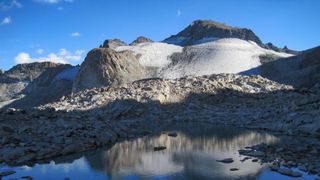Glaciers in Yellowstone and Yosemite on track to vanish within decades, UN report warns
A United Nations report warns of imperiled glaciers at iconic World Heritage sites — but climate action could save most of them.

A third of the world's glaciers in culturally and naturally significant World Heritage sites will almost completely disappear by 2050, a United Nations climate report warns. Without further reductions in greenhouse gas emissions, half of World Heritage glaciers could almost completely vanish after another 50 years.
But if humanity limits the global temperature increase to 2.7 degrees Fahrenheit (1.5 degrees Celsius) above preindustrial levels, two-thirds of World Heritage glaciers could survive, the report said. That 1.5 degree C increase matches a goal of the Paris Agreement, which countries agreed to in 2015 at the U.N. Framework Convention on Climate Change.
"The changes are rapid and really alarming," Daniel Farinotti, a co-author of the new report and a professor of glaciology at ETH Zurich in Switzerland, told Live Science. "If we want to do something about it, we need to reduce global emissions of greenhouse gases, and we need to do that now."
Glaciers projected to disappear by 2050 include those in Yellowstone and Yosemite national parks, and many of the imperiled glaciers provide local communities and ecosystems with vital water resources, according to the report, published this month by the U.N. Educational, Scientific and Cultural Organization (UNESCO). World Heritage sites are legally protected locations with "cultural and natural heritage around the world considered to be of outstanding value to humanity," and UNESCO administers their protections, according to the organization's website.
Related: Study of nearly every glacier on Earth shows ice loss is speeding up
The projected loss of one-third of World Heritage glaciers will happen regardless of future climate mitigation efforts — the damage is already baked in, Tales Carvalho Resende, co-author of the report and a UNESCO project officer, told Live Science.
"Even if we drastically reduce carbon emissions today, these glaciers have an inertia, so they will keep retreating," he said. The so-called "business as usual scenario," with no further reductions in greenhouse gas emissions, sees 50% of World Heritage glaciers lost by 2100.
Get the Space.com Newsletter
Breaking space news, the latest updates on rocket launches, skywatching events and more!
Recent data show the world falling short of its Paris Agreement goals, The New York Times reported. However, UNESCO hopes its report helps spur a recommitment to those efforts. "We believe this can be a strong message to decision-makers, given that these places are iconic for humanity," Carvalho Resende said.
In addition to stressing the urgent need for reduced emissions, UNESCO recommended several adaptive steps. These include improving the monitoring of glaciers; developing early warning systems for floods and other disasters associated with glacial retreat; and working with Indigenous peoples, whose knowledge on managing resources is "embedded in culture, traditional practices and belief systems."
Vital water resources and cultural icons
Losses predicted by 2050 include "the last remaining glaciers in Africa (on Mount Kilimanjaro, Mount Kenya and the Rwenzori-Virunga mountains), as well as other iconic sites in Europe and North America," such as Italy's Dolomites and U.S. national parks, according to the report. The "business-as-usual" scenario would imperil larger glaciers, such as those at Machu Picchu in Peru and Olympic National Park in Washington state.
UNESCO's publication draws from two decades of satellite data on ice loss, as well as models estimating ice thickness, Farinotti said. The nearly 19,000 glaciers at 50 World Heritage sites represent almost 10% of the planet's glacier area, and their retreat has accelerated since 2000. Overall, World Heritage glaciers lost nearly 1,300 billion tons (1,200 billion metric tons) of ice from 2000 to 2020, or an average yearly "amount equivalent to the total annual volume of water consumed in France and Spain together," the report said.
Losing these ice giants will come with enormous costs. They provide habitats for biodiversity, reflective surfaces that help limit warming, and fresh water for drinking and agriculture to half of humanity. Though in the short term, higher global temperatures may increase water flow from melting glaciers, "once a maximum meltwater contribution (peak water) is reached, annual runoff is then reduced as the glacier shrinks" so that it can no longer produce much meltwater, the report said.
This could prove devastating in populous areas, particularly in countries such as India and China, which lie downstream of the Himalayas, Farinotti said. "They get water directly from those mountains," he said. And during "drought, in some areas, either you get water from the glaciers, or you don't get water at all."
Join our Space Forums to keep talking space on the latest missions, night sky and more! And if you have a news tip, correction or comment, let us know at: community@space.com.

Michael Dhar is a manuscript editor at the American Medical Association and a freelance science and medical writer and editor, having written for Live Science, Space.com, Earth.com, The Fix, Scientific American, and others. Michael received a master's degree in Bioinformatics from NYU's Polytechnic School of Engineering, and also has a master's in English and Comparative Literature from Columbia University School of New York, and a bachelor's in English with a biology minor from the University of Iowa.
Most Popular


